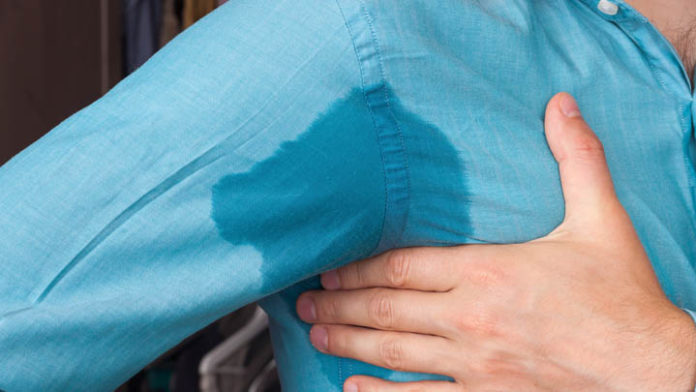Definition of hyperhidrosis
Sweating is a normal physiological phenomenon that the body needs to maintain internal body temperature within normal ratios as well as regulating body level of fluids and electrolytes. Sometimes, excessive sweating may occur on exposure to stress, fear, anger or in cases of vigorous physical exercise. If excessive sweating occurred in paradoxical situations (such as cold weather or in the absence of triggers like stress or fear), it’s a pathological condition, which is medically known as “hyperhidrosis”.
Causes of hyperhidrosis
There are many causes for hyperhidrosis; according to the causative factors, hyperhidrosis can be classified into two main types as follow:
- Primary hyperhidrosis: it’s also known as “focal hyperhidrosis” as excessive sweating mainly occurs in certain areas of the body, such as; palms, heels, scalp, face and armpit. This type of hyperhidrosis usually starts in childhood and positive family history tends to be a significant predisposing factor.
- Secondary hyperhidrosis: it’s also known as “generalized hyperhidrosis” as excessive sweating may occur all over the body or just in one area. Secondary hyperhidrosis mainly develops as a possible side effect of administration of certain drugs (such as; antidepressants or zinc supplements). Also, secondary hyperhidrosis may develop as one of the most significant clinical signs of certain medical conditions, the most common ones include; tuberculosis, parkinsonism, hyperthyroidism, adrenal dysfunction, some cancerous lesions, lung disease, diabetes, low blood sugar, heart attack, stroke, spinal cord injuries, hormonal disorders in females and menopause.
Is hyperhidrosis life-threatening condition?
Hyperhidrosis itself isn’t a life-threatening condition, but it could be a warning sign for serious medical conditions. So, it’s advised to see a doctor if hyperhidrosis is manifested with one or more of the following clinical signs:
- Unexplained progressive weight loss.
- High grade fever.
- Chest pain, shortness of breathing with / without tachycardia.
- Excessive night sweat.
Effects and complications of hyperhidrosis
Having hyperhidrosis usually cause the following effects:
- Recurrent skin infection: due to profuse and excessive sweating.
- Social isolation: due to being ashamed of clothes soaked in sweat and bad smell.
Diagnosis of hyperhidrosis
At first, doctor will ask you detailed questions about excessive sweating. After that doctor will ask for some lab investigations (such as urine analysis, blood glucose level, level of thyroxin hormone… etc.) to find out the cause of hyperhidrosis.
On the same context, some specific sweat tests are performed to detect areas of sweating as well as the severity of hyperhidrosis, these tests mainly include:
- An iodine-starch test: this test involves putting iodine solution on the sweaty areas followed by sprinkling starch over iodine solution. If the solution color is turned into dark blue, it’s a diagnostic sign for hyperhidrosis.
- A paper test: special paper is put in the sweaty areas to absorb sweat. After some time, the paper will be weighed to determine severity of hyperhidrosis.
- Thermoregulatory sweat test: it’s similar to starch-iodine test. A special powder sensitive to moisture is used. If the color of powder is changed, it’s a diagnostic sign for hyperhidrosis.
Treatment of hyperhidrosis
Treatment of hyperhidrosis includes the following therapeutic options:
- Antiperspirant: it’s a specific type of medications that contain aluminum chloride, it aims to reduce sweating.
- Anti-cholinergic drugs: it helps in reducing the stimulation of sweat glands. It should be noted that administration of these drugs may cause some side effects, such as dizziness and constipation.
- Iontophoresis: it’s a procedure in which the patient is submerged in water to get low-level electrical currents emitted by a device. This procedure temporarily blocks the sweat glands.
- Botox: botulinum toxin is injected to block the nerves that stimulate sweat glands.
- Surgery: it’s only indicated in cases of focal hyperhidrosis (in armpit). Surgical options in Turkey include resection of sweat glands in armpit or endoscopic thoracic sympathectomy (removal of the nerve supply of armpit sweat glands).
In addition to the above mentioned measures, it’s advised to apply the following life style modifications:
- Having a shower daily, to prevent bacterial infection of skin.
- Your clothes, socks and shoes should be made of natural materials (cotton for example).
- Your socks should be changed frequently.


